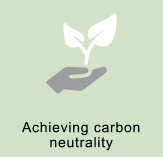Environment
 Environmental Policy
We shall actively work to preserve the global environment and strive to preserve the environment in all of our corporate activities.
Environmental Policy
We shall actively work to preserve the global environment and strive to preserve the environment in all of our corporate activities.
Based on this environmental policy, our Group's code of conduct regarding the environment, which all directors and employees must comply with, is "We shall comply with environmental laws and regulations, always pay attention to environmental preservation, and cooperate with the company's measures to reduce the burden on the environment at every stage of our operations, from technology development, product design, procurement, production, sales, transportation, use and disposal, to recovery."
-
Initiatives toward realization of carbon neutrality
As part of our efforts to prevent global warming, our Group aims to reduce GHG emissions and achieve carbon neutrality. By promoting initiatives such as the use of renewable energy from solar power generation and other sources, promotion of process efficiency reforms, recovery and reuse of waste heat, fuel conversion, switching to energy-efficient equipment, and conversion to green power, we aim to reduce GHG emissions by 46% from the fiscal 2013 level by FY2030 and to become carbon neutral by 2050.

-
Disclosures of Information on Climate Change Response
In accordance with the recommendations of the Task Force on Climate-related Financial Disclosures (TCFD), NIPPON CARBIDE INDUSTRIES GROUP conducts appropriate information disclosures on "Governance," "Risk Management," "Strategy," and "Indicators and Targets". By recognizing and analyzing the risks and opportunities of climate change, we will take concrete measures and take action toward the early realization of a decarbonized society.
- Governance
-
Climate change-related issues are discussed by the Risk Management Committee and reported regularly to the Board of Directors.
The Risk Management Committee has put in place a system to deal with climate change in an appropriate manner by establishing the TCFD Promotion Team as a working-level discussion and response organization to deal with climate change-related issues. The Board of Directors receives the reports, conducts monitoring and continuously supervises activities aimed at addressing climate change, and setting and achieving GHG reduction targets.
- Risk Management
- The Risk Management Committee, with the Corporate Planning Department acting as its secretariat, has established a system to appropriately address important risk issues related to sustainability in general. The Risk Management Committee identifies important risks each year and determines which departments and divisions are responsible for addressing them. The Risk Management Committee meets four times a year to receive reports on countermeasures, action plans, progress, etc., for each issue from the department or division in charge, and to reduce risks through deliberations at meetings attended by all executive officers. The Board of Directors is in a position to supervise the Risk Management Committee, receiving reports twice a year from the committee, and is involved in overall risk activities, including basic risk management policies, identification of important risks, determination of important measures, monitoring of measures and instructions for improvement.
- Strategies
-
NIPPON CARBIDE INDUSTRIES GROUP aims to grow sustainably with society through contributing to resolutions of issues related to climate change impacts and mitigation and other climate change-related issues, and recognizes that addressing climate change is an important sustainability issue. We have examined the risks and opportunities of climate change impacts under the scenarios of average temperatures of "4℃" and "less than 2℃." As a result, we have identified risks including the introduction of carbon tax, increased energy costs, increased investment in renewable energy and energy-saving facilities, and damage to facilities due to more severe natural disasters. in addition, we are expecting opportunities including increased demand for decarbonization facilities and zero-carbon steel, increased EV-related demand, and increased demand for hydrogen fuel production facilities.
Our Group will continue to mitigate risks by responding in a timely manner to changes in global warming policies and other factors, and aim for sustainable growth and increased corporate value through initiatives that contribute to further mitigating the effects of climate change.
Overview of risks and opportunities related to climate change
| Type | Description | Impact | Response | |
|---|---|---|---|---|
| Transition risk | Policy and Regulation |
|
Medium |
|
|
|
|||
| Market |
|
Medium |
|
|
| Technology |
|
Medium |
|
|
| Reputation |
|
Small |
|
|
| Physical Risks | Chronic |
|
Large |
|
| Acute |
|
Large |
|
|
| Opportunities | Resource efficiency |
|
Medium |
|
| Reputation |
|
Medium |
|
|
| Products, Services, etc. |
|
Medium |
|
|

